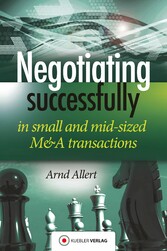Search and Find
Service
More of the content

Negotiating successfully - Negotiating successfully in small and mid-sized M&A transactions
List of figures
Figure 1 The M&A process flow, using the example of the sale of an enterprise
Figure 2 Selection of possible areas of conflict
Figure 3 The classic Lehman Formula
Figure 4 Different compensation combinations for M&A consulting services
Figure 5 Example of the economic development of a company
Figure 6 Model calculation for the continuation scenario (contribution to a foundation)
Figure 7 Model calculation for the liquidation scenario
Figure 8 Model calculation for the IPO scenario
Figure 9 Comparable companies – overview
Figure 10 Range of values in the IPO scenario
Figure 11 Sample comparison of alternatives for action
Figure 12 Schematic diagram of the creation of a ZOPA
Figure 13 Summary of theoretical negotiation principles
Figure 14 Selection of key factors influencing a negotiator in M&A transactions
Figure 15 Message - Sender - Receiver model
Figure 16 Domination, equality and subordination in transactional analysis
Figure 17 The 4 sides of a message
Figure 18 Occasion-related stressors in M&A transactions
Figure 20 Hormones produced in the human brain
Figure 21 Ways of coping with stress in M&A transactions
Figure 22 Sphere of responsibility and sphere of influence
Figure 23 Maslow's pyramid of needs
Figure 25 The basic principles of the Harvard Concept
Figure 26 Potential liability risks I
Figure 27 Potential liability risks II
Figure 28 Potential liability risks III
Figure 29 Pay-off diagram of the prisoners' dilemma
Figure 30 Pay-off diagram of the negotiator’s dilemma
Figure 31 Problem areas of the application of cooperative negotiating
Figure 32 Example of a complex decision-tree
Figure 33 Example of a pay-off matrix
Figure 35 Bids for drilling licenses
Figure 36 Results of an experiment conducted by the author with 1,000 rolls of the die
Figure 38 Example of the economic development of a company
Figure 39 Definition of the expected value of the value drivers
Figure 40 Value drivers and likelihoods of occurrence
Figure 41 Risk simulation of a value driver with right-skewed distribution
Figure 42 Monte Carlo simulation of the terminal value with equal distribution
Figure 43 Income statement after conducting a Monte Carlo simulation
Figure 44 Determination of the enterprise value using Monte Carlo simulation
Figure 45 Division of the determined enterprise value in intervals
Figure 46 Analysis of the risk of a total loss
Figure 47 Value drivers and modified likelihoods of occurrence
Figure 49 Intuitive, competitive negotiation vs. rational, cooperative negotiation
Figure 50 Relevant factors in international negotiations
Figure 51 Influence of a country's culture on the negotiation style
Figure 52 Analysis of the motives in the course of the M&A process
Figure 53 Forms of conflicts of interest of seller and management
Figure 55 Interests of different groups of investors
Figure 56 Preparation of the longlist as next step in the M&A process
Figure 57 Identification of suitable target companies as part of the preparation of a longlist
Figure 58 Preparation of the information memorandum and other documents in the M&A process
Figure 59 Sample outline of an information memorandum
Figure 60 Sample outline of a financial factbook
Figure 61 Sample outline of a teaser – page 1
Figure 62 Sample outline of a teaser – page 2
Figure 63 Dependency of the valuation method on the quality of information
Figure 65 Complexity of determining value price
Figure 67 Distinction between traditional enterprise valuation and valuation guideline
Figure 68 Present value concept vs. IRR concept
Figure 69 IDW's concept of functions
Figure 70 Overview of the most common valuation methods
Figure 71 Simplified reconciliation from enterprise value to equity value
Figure 73 Arguments for enterprise values
Figure 74 Sensitivity analysis of the effects of different WACC and beta factors
Figure 75 Selection of a peer group
Figure 76 Rough calculation for the determination of the implied beta factor of a multiple
Figure 77 Various multiples and the corresponding length of distribution
Figure 78 Sample DCF analysis with implied multiples and sensitivity analyses
Figure 79 Selection of the sales process in the overall M&A process
Figure 81 First-price sealed-bid auction
Figure 84 Summary of standard auction rules
Figure 85 Overview of the features of the different sales processes
Figure 86 Seller objectives in the selection of the M&A sales process
Figure 87 The perfect number of bidders
Figure 88 "Magic triangle" in the transaction process
Figure 90 “Handelsblatt Online”
Figure 89 Newspaper article in the Financial Times Germany of 9 July 2012
Figure 91 “Reuters Deutschland”
Figure 92 Comparison of negotiation and auction
Figure 93 Three elements of a negotiauction
Figure 94 Overview of offers – phase 1
Figure 95 Overview of offers – phase 2
Figure 96 Sounding & Approach in the overall M&A process
Figure 97 Risks and opportunities profiles of the basic merger strategy types
Figure 98 Exchange of first transaction documents in the M&A process
Figure 99 Management presentation in the transaction process
Figure 100 Stages of a management presentation
Figure 101 Example of an abbreviated investor profile
Figure 102 Success factors of a management presentation 1
Figure 103 Success factors of a management presentation 2
Figure 105 Feature-advantage-benefit table
Figure 106 Obtaining non-binding offers in the M&A process
All prices incl. VAT












